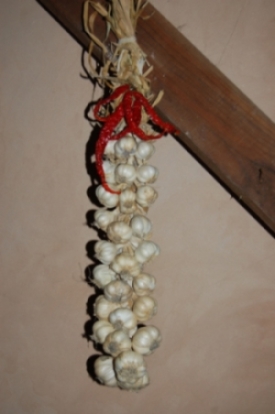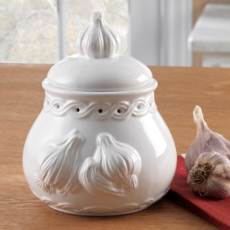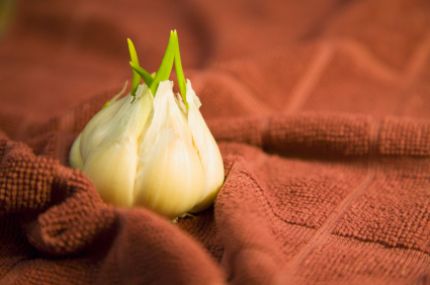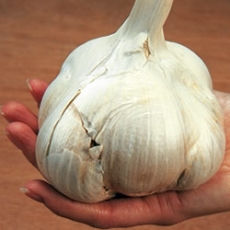Garlic Essentials
That Everyone Should Know
By Alice Osborne
 I have a terra cotta garlic keeper in the cooking center in my kitchen. I'm told it's the best way to "keep" garlic today. But wonderful "keeper" aside, I've lost enough garlic in my life to have found it necessary to research what the heck is going on. I pass this information on to you in case you've dealt with the same conundrum.
I have a terra cotta garlic keeper in the cooking center in my kitchen. I'm told it's the best way to "keep" garlic today. But wonderful "keeper" aside, I've lost enough garlic in my life to have found it necessary to research what the heck is going on. I pass this information on to you in case you've dealt with the same conundrum.
First, let's accept the fact that no matter the fancy "keeper," garlic can go bad. Garlic cloves kept too long can shrivel and soften, and dark spots can appear. Garlic at this stage will taste a lot hotter; it won't make you ill, but it's not pleasant and more difficult to work with.
In the old days, garlic was usually stored and dried hanging from a ceiling. You've seen those quaint garlic "ropes"? Unfortunately, most of today's kitchens are warm, frequently humid, and often sunny. It's for these reasons that folks have turned to garlic keepers to store whole bulbs and unused cloves.

 A garlic keeper is a small pot which has holes in the sides to allow air to circulate. They're made from various materials—ceramic, marble, and terra cotta. And don't be fooled by price; this only reflects the materials used and the degree of fanciness in design. As long as the pot has holes in the side, it's more than adequate.
A garlic keeper is a small pot which has holes in the sides to allow air to circulate. They're made from various materials—ceramic, marble, and terra cotta. And don't be fooled by price; this only reflects the materials used and the degree of fanciness in design. As long as the pot has holes in the side, it's more than adequate.
While garlic is available year round, new crops are harvested when it's at its peak in June and July. No matter what time of year, when buying, you want bulbs with firm and fat cloves and lots of papery covering. And when storing, keep bulbs in an open container in a cool place, out of sunlight. But cool place doesn't mean the fridge—too much cool encourages sprouting and even mold growth.
And speaking of sprouting, have you ever wondered if it's safe to eat garlic once it's begun to sprout? Me too. Here's the essential answer: As long as the individual cloves are firm and crisp, they can still be used. Garlic sprouts are usually bitter, however, so they should be removed—don't bother trying to use them. To remove, cut down both sides of the clove and simply pull out the sprout. The remaining clove will have a milder flavor, so if pungency is what you're after, you'll want to add more garlic than your recipe calls for.

Besides the great flavor punch garlic lends to savory recipes, there are two main medicinal ingredients which produce important health benefits: allicin and diallyl sulphides. Modern science has proven that garlic is a powerful natural broad-spectrum antibiotic. The bacteria in the body don't appear to evolve resistance to garlic as they do to many modern pharmaceutical antibiotics. This means that its positive health benefits can continue over time rather than helping to breed antibiotic resistant "superbugs."
Be careful with this health thing, though. Even garlic isn't a perfect food, though. Apart from garlic breath there are other possible side effects, especially if used to excess. For instance, raw garlic is very strong, so eating too much could produce problems, such as irritation of or even damage to the digestive tract.
 When buying garlic, avoid being tempted by the very large elephant garlic. Although this looks wonderful, the taste is not at all the same and it is no substitute for ordinary garlic.
When buying garlic, avoid being tempted by the very large elephant garlic. Although this looks wonderful, the taste is not at all the same and it is no substitute for ordinary garlic.
A single bulb of garlic usually contains between ten and twenty individual cloves of garlic. Individual cloves are covered with a fine pinkish/purple skin. The head of cloves is then covered with white papery outer skin. Don't confuse cloves and bulbs! Neither the inner nor outer skins should be eaten.
Now let's talk about successful garlic preparation:
- To prepare garlic, first strip off some of the papery covering from the bulb. Now ease out as many cloves as required. Garlic cloves come in a wide variety of sizes, so the numbers given in a recipe should be treated as a rough guide only. Once you get used to cooking with garlic, you will probably find yourself using more than the recipe states.
- You really don't need a garlic presses or other gadget for clove-crushing. It's easy to crush garlic with only a knife and a little salt.
- In general, the finer the chop the stronger the taste. Crushed garlic has the strongest taste of all and if used raw is only for the real aficionado.
- When cooked, whole garlic has a much milder, rather sweet taste. The famous recipe, "chicken with forty cloves of garlic," uses whole garlic cloves not crushed, for instance.
- Garlic also mellows the longer it is cooked. Garlic added at the end of cooking will give a stronger taste than garlic prepared the same way but added earlier. You can also buy ready-prepared black garlic which has a distinctive sweet taste and dark, sticky cloves.
- Finally, I close with garlic breath (figuratively, not literally!). We know it when we smell it, and the old wives' tale that raw parsley helps alleviate this is true—it does assist this condition and this may be the reason why so many garlic recipes include a little chopped parsley or a lovely fresh sprig as a side garnish (take my advice and eat that sprig!).
- www.amazon.com
- www.earthstorehouse.blogspot.com
- www.answers.chefscatalog.com
- www.webanswers.com
- www.onlyfoods.net

Alice Osborne
Weekly Newsletter Contributer since 2006

